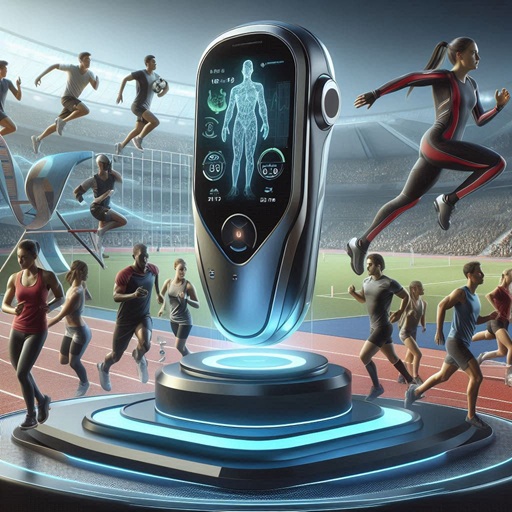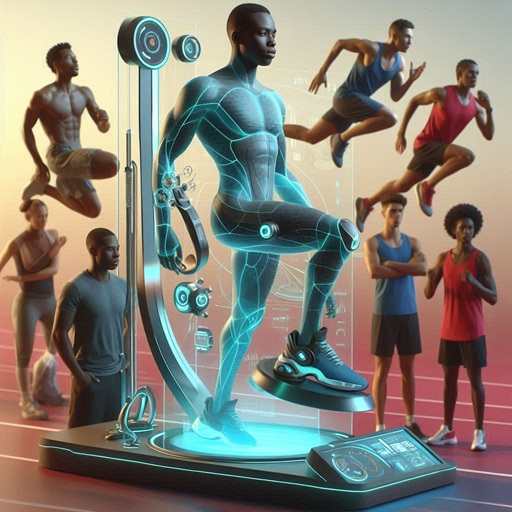The Sports Tech Market is revolutionizing the way we play, watch, and engage with sports. From wearable devices to advanced analytics, the integration of technology in sports is creating a paradigm shift in the industry. This article delves deep into the Sports Tech Market, exploring its current trends, key innovations, and future growth opportunities. Whether you’re a sports enthusiast, a tech geek, or an industry professional, this comprehensive guide will provide you with valuable insights into the rapidly evolving world of sports technology.
The Sports Tech Market refers to the application of technology to enhance athletic performance, improve fan engagement, and streamline sports management. This market encompasses a wide range of technologies, including wearable devices, data analytics, virtual reality (VR), augmented reality (AR), artificial intelligence (AI), and more. The Sports Tech Market is not just limited to professional sports; it also extends to amateur and recreational sports, fitness, and wellness.
The Global Sports Tech Market: A Rapidly Growing Industry
The global Sports Tech Market is projected to experience significant growth, expanding from USD 34.25 billion in 2025 to USD 68.70 billion by 2030, reflecting a compound annual growth rate (CAGR) of 14.9% during the forecast period. This remarkable growth is driven by advancements in wearable technology, data analytics, and artificial intelligence (AI), which are revolutionizing how athletes optimize performance and reduce injuries. Additionally, the rising demand for personalized fitness experiences and real-time feedback from consumers is fueling innovation in fitness tracking devices and smartwatches.
The integration of augmented reality (AR) and virtual reality (VR) for training and fan engagement is also creating new opportunities in the Sports Tech Market. These immersive technologies are not only enhancing athlete performance but also transforming how fans interact with their favorite sports. Furthermore, increased investments by sponsors, broadcasters, sports associations, and clubs, along with strategic partnerships and collaborations with leagues and sports companies, are propelling the market forward. These investments aim to enhance both athletic performance and the overall viewing experience for fans.
The growing popularity of fitness bands, fitness trackers, and smartwatches is another key driver of the Sports Tech Market. As consumers become more health-conscious and seek advanced tools to monitor their fitness goals, the demand for these devices continues to rise. Together, these factors are shaping the future of the Sports Tech Market, making it one of the most dynamic and innovative sectors in the global economy.
Download PDF Brochure @ https://www.marketsandmarkets.com/pdfdownloadNew.asp?id=104958738
Key Segments of the Sports Tech Market
- Wearable Technology: Devices like fitness trackers, smartwatches, and GPS-enabled wearables that monitor physical activity, heart rate, and other vital metrics.
- Data Analytics: Tools that analyze player performance, game strategies, and fan behavior to provide actionable insights.
- Virtual and Augmented Reality: Immersive technologies that enhance fan experiences and provide virtual training environments for athletes.
- E-Sports: Competitive video gaming, which has become a significant segment of the Sports Tech Market.
- Smart Stadiums: Venues equipped with advanced technologies like IoT sensors, mobile apps, and high-speed connectivity to enhance the fan experience.
- Sports Management Software: Platforms that streamline operations, from scheduling and ticketing to player management and marketing.
Current Trends in the Sports Tech Market
The Sports Tech Market is evolving at a rapid pace, driven by advancements in technology and changing consumer preferences. Here are some of the most notable trends shaping the industry:
1. Rise of Wearable Technology
Wearable technology is one of the most significant trends in the Sports Tech Market. Athletes and fitness enthusiasts are increasingly using devices like smartwatches, fitness bands, and GPS-enabled wearables to monitor their performance. These devices provide real-time data on metrics such as heart rate, calories burned, distance covered, and more. This data is invaluable for optimizing training regimens and preventing injuries.
2. Data-Driven Decision Making
Data analytics is transforming the way sports teams and organizations make decisions. By analyzing player performance data, teams can identify strengths and weaknesses, develop game strategies, and make informed decisions about player recruitment and training. Data analytics is also being used to enhance fan engagement by providing personalized content and recommendations.
3. Immersive Fan Experiences
Virtual and augmented reality technologies are revolutionizing the way fans experience sports. VR allows fans to experience games as if they were sitting in the stadium, while AR enhances the live experience by overlaying digital information on the real world. These technologies are also being used to create virtual training environments for athletes, allowing them to practice in realistic scenarios without the risk of injury.
4. Growth of E-Sports
E-Sports has emerged as a major segment of the Sports Tech Market. Competitive video gaming has grown into a multi-billion-dollar industry, with professional leagues, tournaments, and a massive global audience. The rise of e-sports has also led to the development of specialized gaming hardware, software, and streaming platforms.
5. Smart Stadiums
Smart stadiums are becoming increasingly popular as sports organizations look to enhance the fan experience. These venues are equipped with advanced technologies like IoT sensors, mobile apps, and high-speed connectivity to provide fans with a seamless and immersive experience. From mobile ticketing and cashless payments to real-time stats and replays, smart stadiums are redefining the way fans engage with sports.
6. AI and Machine Learning
Artificial intelligence and machine learning are playing a crucial role in the Sports Tech Market. These technologies are being used to analyze player performance, predict game outcomes, and optimize training programs. AI is also being used to enhance fan engagement by providing personalized content and recommendations.
Key Innovations in the Sports Tech Market
The Sports Tech Market is characterized by continuous innovation, with new technologies and solutions being developed to address the evolving needs of athletes, teams, and fans. Here are some of the key innovations driving the industry:
1. Biometric Monitoring
Biometric monitoring devices are becoming increasingly sophisticated, providing athletes with detailed insights into their physical condition. These devices can monitor metrics like heart rate, oxygen levels, and muscle activity, allowing athletes to optimize their performance and reduce the risk of injury.
2. Advanced Analytics Platforms
Advanced analytics platforms are enabling sports organizations to make data-driven decisions. These platforms use machine learning algorithms to analyze vast amounts of data, providing insights into player performance, game strategies, and fan behavior. This data is invaluable for optimizing team performance and enhancing fan engagement.
3. Virtual Reality Training
Virtual reality is being used to create realistic training environments for athletes. VR training allows athletes to practice in a controlled environment, reducing the risk of injury and improving performance. This technology is particularly useful for sports that require high levels of precision and coordination, such as golf, tennis, and baseball.
4. Augmented Reality Fan Engagement
Augmented reality is enhancing the fan experience by overlaying digital information on the real world. AR apps can provide fans with real-time stats, player information, and interactive experiences, making the live sports experience more engaging and immersive.
5. AI-Powered Coaching
AI-powered coaching platforms are revolutionizing the way athletes train. These platforms use machine learning algorithms to analyze performance data and provide personalized training recommendations. AI coaching is particularly useful for individual sports like running, cycling, and swimming, where personalized training programs can make a significant difference in performance.
6. Smart Equipment
Smart equipment is becoming increasingly popular in the Sports Tech Market. From smart basketballs that track shooting accuracy to smart tennis rackets that analyze swing mechanics, these devices provide athletes with detailed insights into their performance. Smart equipment is also being used to enhance fan engagement, with some devices allowing fans to interact with the game in real-time.
Future Growth Opportunities in the Sports Tech Market
The Sports Tech Market is poised for significant growth in the coming years, driven by advancements in technology and increasing demand for innovative solutions. Here are some of the key growth opportunities in the industry:
1. Expansion of E-Sports
E-Sports is expected to continue its rapid growth, with new leagues, tournaments, and platforms emerging. The increasing popularity of e-sports is also driving demand for specialized gaming hardware, software, and streaming platforms, creating new opportunities for companies in the Sports Tech Market.
2. Integration of 5G Technology
The rollout of 5G technology is expected to have a significant impact on the Sports Tech Market. 5G will enable faster data transfer, lower latency, and more reliable connectivity, enhancing the performance of technologies like VR, AR, and IoT. This will create new opportunities for companies developing smart stadiums, wearable devices, and immersive fan experiences.
3. Personalized Fan Experiences
As sports organizations look to enhance fan engagement, there is a growing demand for personalized experiences. Technologies like AI, machine learning, and data analytics are being used to provide fans with personalized content, recommendations, and interactive experiences. This trend is expected to drive growth in the Sports Tech Market, with companies developing innovative solutions to meet the evolving needs of fans.
4. Health and Wellness
The growing focus on health and wellness is creating new opportunities in the Sports Tech Market. Wearable devices, fitness apps, and health monitoring platforms are becoming increasingly popular, as consumers look for ways to track and improve their physical condition. This trend is expected to drive demand for innovative health and wellness solutions, creating new opportunities for companies in the Sports Tech Market.
5. Sustainability in Sports
Sustainability is becoming an increasingly important issue in the sports industry, with organizations looking for ways to reduce their environmental impact. This trend is creating new opportunities for companies in the Sports Tech Market, with innovative solutions being developed to promote sustainability in sports. From energy-efficient stadiums to eco-friendly sports equipment, there is a growing demand for sustainable solutions in the industry.
Challenges in the Sports Tech Market
While the Sports Tech Market offers significant growth opportunities, it also faces several challenges. These include:
1. High Costs
The development and implementation of advanced technologies can be expensive, particularly for smaller sports organizations. High costs can be a barrier to entry for some companies, limiting their ability to compete in the Sports Tech Market.
2. Data Privacy and Security
The increasing use of data analytics and AI in sports raises concerns about data privacy and security. Sports organizations must ensure that they are collecting, storing, and using data in a way that protects the privacy of athletes and fans. Failure to do so can result in legal and reputational risks.
3. Regulatory Challenges
The Sports Tech Market is subject to a range of regulations, particularly in areas like data privacy, health and safety, and intellectual property. Navigating these regulations can be challenging, particularly for companies operating in multiple jurisdictions.
4. Adoption Barriers
While technology is transforming the sports industry, there are still barriers to adoption. Some athletes, coaches, and fans may be resistant to change, particularly if they are not familiar with new technologies. Companies in the Sports Tech Market must work to overcome these barriers by providing user-friendly solutions and educating their target audience.
The Sports Tech Market is at the forefront of innovation, transforming the way we play, watch, and engage with sports. From wearable devices and data analytics to virtual reality and AI, technology is driving significant changes in the industry. As the Sports Tech Market continues to evolve, it offers exciting opportunities for companies, athletes, and fans alike. However, it also faces challenges, including high costs, data privacy concerns, and regulatory hurdles. By addressing these challenges and continuing to innovate, the Sports Tech Market is poised for a bright future.
FAQs
1. What is the Sports Tech Market?
The Sports Tech Market refers to the application of technology to enhance athletic performance, improve fan engagement, and streamline sports management. It includes technologies like wearable devices, data analytics, virtual reality, augmented reality, and artificial intelligence.
2. What are the key segments of the Sports Tech Market?
The key segments of the Sports Tech Market include wearable technology, data analytics, virtual and augmented reality, e-sports, smart stadiums, and sports management software.
3. What are the current trends in the Sports Tech Market?
Current trends in the Sports Tech Market include the rise of wearable technology, data-driven decision making, immersive fan experiences, growth of e-sports, smart stadiums, and the use of AI and machine learning.
4. What are the key innovations in the Sports Tech Market?
Key innovations in the Sports Tech Market include biometric monitoring, advanced analytics platforms, virtual reality training, augmented reality fan engagement, AI-powered coaching, and smart equipment.
5. What are the future growth opportunities in the Sports Tech Market?
Future growth opportunities in the Sports Tech Market include the expansion of e-sports, integration of 5G technology, personalized fan experiences, health and wellness, and sustainability in sports.
6. What are the challenges in the Sports Tech Market?
Challenges in the Sports Tech Market include high costs, data privacy and security concerns, regulatory challenges, and adoption barriers.
7. How is AI used in the Sports Tech Market?
AI is used in the Sports Tech Market to analyze player performance, predict game outcomes, optimize training programs, and enhance fan engagement by providing personalized content and recommendations.
8. What is the role of wearable technology in the Sports Tech Market?
Wearable technology plays a crucial role in the Sports Tech Market by providing athletes and fitness enthusiasts with real-time data on metrics like heart rate, calories burned, and distance covered. This data is used to optimize performance and prevent injuries.
9. How is virtual reality used in the Sports Tech Market?
Virtual reality is used in the Sports Tech Market to create realistic training environments for athletes and enhance fan experiences by allowing them to experience games as if they were sitting in the stadium.
10. What are smart stadiums?
Smart stadiums are venues equipped with advanced technologies like IoT sensors, mobile apps, and high-speed connectivity to enhance the fan experience. These technologies provide fans with a seamless and immersive experience, from mobile ticketing to real-time stats and replays.



